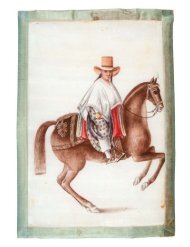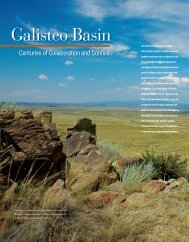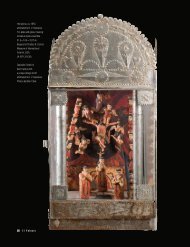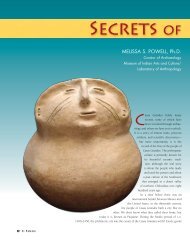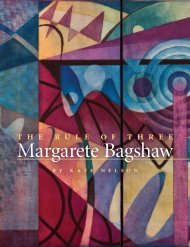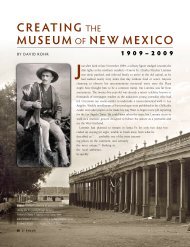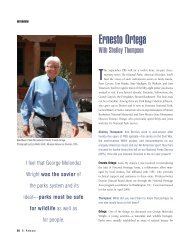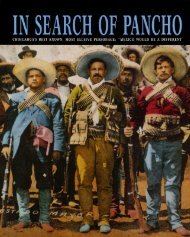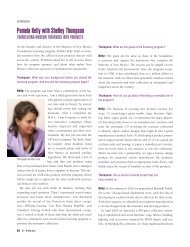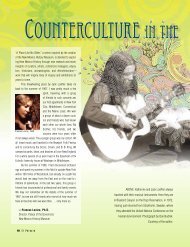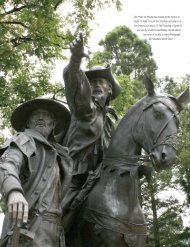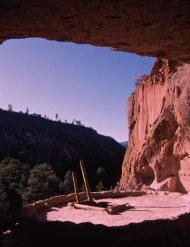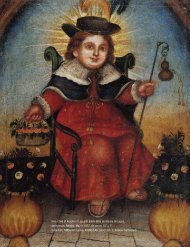You also want an ePaper? Increase the reach of your titles
YUMPU automatically turns print PDFs into web optimized ePapers that Google loves.
<strong>And</strong> <strong>La</strong> <strong>Bruja</strong>Brought the SunflowersTHE BENEFITS AND COSTS OF ANGLO ARTS PATRONAGEBy Lois P. Rudnick34 <strong>El</strong> <strong>Palacio</strong>
<strong>La</strong> <strong>Bruja</strong>The sunflowers of northern New Mexico are one of the sumptuousvisual delights for residents and visitors in summertime.But they are also an invasive weed. In fact, it was rumoredby the Hispanos of Taos Valley that arts patron Mabel DodgeLuhan inflicted them on their crops after she arrived in 1918.This dramatic legend is a paradigm of one of the most fascinating— and controversial — aspects of New Mexico’s culturalhistory: the benefits and costs of Anglo patronage of Hispanoand Native American arts.Mabel Dodge Luhan started collecting santos (Hispanoreligious carvings) soon after she moved to Taos. One of thefirst Anglo patrons to promote them as an art form, she senther collection to a New York City gallery for a show in 1919,probably the first on the East Coast. In 1925 she published anarticle in The Arts magazine titled “The Santos of New Mexico.”As a self-proclaimed expert who touted the artistic significanceof Hispano religious woodcarving, she was shocked whenTaoseños who read her article were outraged because shedescribed their religious practices as “primitive” and “masochistic.”In an unpublished memoir she wrote in 1947, Luhanrecalled the origins of the sunflower legend:[T]he Mexicans had begun to look on me as a kind of witch;for the first summer I came, the sunflowers started in theValley. They hopped up in all the crops and great bandsof them lined the highways. They came right on after that,summer after summer. The Mexicans blamed me for them!“That woman,” they said. “Never before had they had the pestof sunflower weeds until she came and brought them with her!”They spread the rumor that I had strewn the seed all over thevalley from my native New York state!Mabel donated her santos to the Harwood Museum of Art inTaos soon after these events. The collection — still on view atthe museum — is an undoubted treasure, but Luhan’s patronageexemplifies a much more complicated story.Why Did the Anglo ExpatriatesCome to New Mexico?It took New Mexico sixty-four years to go from territorial statusto US statehood, in 1912, primarily because it was a majorityminoritystate, whose predominantly non-white, Spanishspeaking,Catholic population made most Americans consider itun-American. Over the course of the early twentieth century inNew Mexico, Anglo artists, writers, and patrons helped to transformPueblo Indians from a disparaged “vanishing race” to thesublime spiritual healers of the nation; and nuevomexicanos — atleast those of the middle and upper classes — from degradedmestizos to descendants of white Spaniards who had brought adistinguished civilization to the nation. By the 1920s, leaders ofthe Anglo arts communities in Santa Fe and Taos were arguingthat northern New Mexico was, because of its Native Americanand Hispano populations, the most American of places, and thebest source of inspiration for a revitalized national culture.The leaders of the Anglo arts communities of Santa Fe andTaos, most of whom hailed from major urban centers on theEast Coast and the Midwest, perceived northern New Mexicoas a New World whose terrain, climate, and Native and Hispanopeoples offered a model of ecological, spiritual, and artisticintegration for an alienated and decadent Western civilization.Their views were rooted in their own personal needs, as well asin more public ideals of honoring the long-ignored social andcultural contributions of Hispanos and Indians to the life of theregion and the nation. They were antimodern moderns whowere fleeing a nation that had become an industrial, commercial,urbanized world power by the dawn of the twentiethcentury, one invested in war, militarism, and mass productionand consumption, and in what the Anglo patrons viewed astawdry popular and middlebrow cultures.In their flight from urban America, Anglo artists, writers,and patrons were also escaping the social and cultural impactsof class and labor warfare, and in some cases, bad health.Sunmount Sanitarium in Santa Fe was an incubator for severalmen and women who would become political, social, literary,and business leaders of the state. They saw themselves as agentsOpposite left: Gerald Cassidy, Cui Bono? (detail), ca. 1911.Oil on canvas, 93 ½ × 48 in. Collection of the New Mexico Museum of Art.Gift of Gerald Cassidy, 1915, 282.23P. The title, which translates as“Who Benefits?” raises important ethical and political questions aboutthe relationships among the Indian subjects of Anglo paintings, the artistswho used them as models, and the viewers / tourists who look at them.Opposite right: Mabel Dodge Sterne, ca. 1918, photo courtesy ofThe Beinecke Rare Book and Manuscript Library, Yale University.Soon after arriving in Taos, in January 1918, Mabel cut off her long hairand sported an Indian serape, hoping to attain some of the serenitythat she associated with Pueblo women.<strong>El</strong> <strong>Palacio</strong> 35
depends on an attraction to the cultural exoticism of nativepopulations and their art, architecture, music, food, clothing,dance, and rituals.A City of WomenSanta Fe, and Taos to a lesser degree, was a city of women, or“a city of ladies,” to borrow Mary Austin’s quaint phrase. Anglowomen were leaders in the arts and patronage fields and centralto the civic and institutional life of the city. In fact, Santa Fe andTaos may have been the only American communities in theinterwar years whose artist and writer colonies were dominatedby women. Here they found opportunities to create new fieldsand institutions by promoting previously devalued arts andcrafts for which they could become cultural brokers and arbitersof value and authenticity. They enjoyed kinds of freedom,authority, and power that would not have been possible in theplaces from which they came. The experiences of a few of theseremarkable women illuminate some of the complex tensionsinvolved in their art, writing, and patronage.Alice Corbin Henderson Associate editor of Poetry magazine,the premier modern poetry journal in the early twentieth-centuryUS, Alice Corbin Henderson came to Santa Fe in 1916, sufferingfrom tuberculosis. A tireless advocate of the Southwest in herprose and poetry, including her publications of Hispano folksongs and cowboy songs, she was actively involved in the creationTop: Margretta Dietrich spoofing a proposal for a Chautauquafor Santa Fe, August 4 – 7, 1926. Courtesy Palace of the Governors PhotoArchives (NMHM/DCA), Neg. No. 010932. Dietrich’s Fiesta float waspart of a successful battle to keep the Texas Federation of Women’s Clubsfrom building a “culture” center which she and other Santa Fe patronsbelieved threatened the lofty cultural values they promoted.Middle: Interior of “The Native Market,” ca. 1934. Courtesy AcequiaMadre House. Leonora Frances Curtin created and subsidized this store,which demonstrated and sold Hispanic craft making and arts during theGreat Depression. It stayed in business from 1934 to 1940.Bottom: Kenneth Chapman sketching designs on Pueblo pottery,ca. 1915. Courtesy Palace of the Governors Photo Archives (NMHM/DCA),Neg. No. 013312. Chapman created numerous portfolios of traditionalPueblo pottery designs and headed the Pueblo Pottery Fund. He wasphotographed here in the <strong>La</strong>boratory of Anthropology.<strong>El</strong> <strong>Palacio</strong> 37
of the Indian Arts Fund (1925) and the New Mexican Associationfor Indian Affairs (1922), for which she invented the “PoetsRound-Up”: in a rodeo-like setting, Santa Fe poets came out ofcardboard chutes reading poems to raise money for the organization.The first poem that Henderson published after her arrivalin Santa Fe, “Litany in the Desert,” speaks eloquently about theravages of World War I and industrialism on the Western world:“On the other side of the Sangre de Cristo Mountains, there isa great welter of steel and flame. … I know nothing of it here. …I do not know why men fight and die. I do not know why mensweat and slave. I know nothing of it here.”But many nuevomexicanos did “sweat and slave” — perhapsnot in urban factories but certainly as day and migrant laborerson commercial farms and in the mines of New Mexico andColorado, increasingly so throughout the 1920s and 1930s,when the rural economy was in serious decline. This is somethingHenderson would not have known in 1916 but that shemust have known after she had lived among Hispanos formany years on Camino del Monte Sol (she was responsible forits name change from “Telephone Road”). Yet neither she norany of her Anglo patron colleagues wrote or painted about thepoverty or the racial and class tensions that were part of dailylife in northern New Mexico and from which they benefitedpersonally in terms of inexpensive day labor, domestic work,and models for their art.Mabel Dodge (Luhan) Mabel Dodge (Luhan) had been aleading patron of the radical avant-garde in politics and theTop: Poet Alice Corbin Henderson and her husband, painterWilliam Penhallow Henderson, 1932. Photo by Will Connell. CourtesyPalace of the Governors Photo Archives (NMHM/DCA), Neg. No. 059757.Middle: Patio, Palace of the Governors, Fiesta, 1925. From left toright are Mayor Nathan Jaffa, Oskenonton (chief of a Canadian Mohawktribe), Edgar L. Hewett, and José D. Sena, Jr., a prominent Hispano civicleader. Courtesy Palace of the Governors Photo Archives (NMHM/DCA),Neg. No. 007271. The City Different’s leading cultural impresario, Hewettplayed a key role in shaping the image of “historic” Santa Fe and in severalimportant cultural institutions.Bottom: Julian and Maria Martinez making pottery, San IldefonsoPueblo, ca. 1950, for the New Mexico State Tourist Bureau. Courtesy Palaceof the Governors Photo Archives (NMHM/DCA), Neg. No. 009185.38 <strong>El</strong> <strong>Palacio</strong>
arts in Greenwich Village between 1912 and 1915. But after shediscovered the Pueblos, she wrote in her 1937 memoir, Edgeof Taos Desert: An Escape to Reality, she was converted from theindividual to the tribal:The singular raging lust for individuality and separatenesshad been impelling me all my years as it did everyone elseon earth — when all of a sudden I was brought up againstthe Tribe, where a different instinct ruled, where a differentknowledge gave power from any I had known, and wherevirtue lay in wholeness instead of in dismemberment.Unlike any other of her Anglo peers, Luhan married a PuebloIndian, Antonio Lujan, from Taos. Mabel was responsible forputting Taos on the map of modern art by bringing majorwriters, artists, and social reformers to northern New Mexico,who painted, photographed, and wrote about the beautyand power of its physical and cultural landscapes — GeorgiaO’Keeffe, Ansel Adams, and D. H. <strong>La</strong>wrence among them. Butin her publications and activism, she presented the Pueblosas a single entity, without any assertion of individual will orinterest in modern progress. Perhaps her greatest contributionto Pueblo welfare was bringing John Collier to northern NewMexico, where he began a thirty-year campaign for Indian civiland political rights, most effectively (though controversially) inthe “Indian New Deal” he was able to legislate as commissionerof Indian affairs under President Franklin Delano Roosevelt.Mary Austin Mary Austin had been a pioneer homesteaderin Owens Valley, California, a bioregionalist on water issues,a prolific writer, and an activist for Native American rightsbefore she settled in Santa Fe in 1924. Austin wrote about theSouthwest in prophetic terms, most dramatically her 1924 book,<strong>La</strong>nd of Journey’s Ending:Here in the Southwest, and along the western coast, whereour blood-stream reaches its New-World journey’s ending,it finds itself possessed, with no effort, along with beauty andfood — and power-producing natural resources, of a competentalphabet of cultural expression. Thus it gains so enormouslyover all other sections, … that one confidently predicts the risethere, within appreciable time, of the next great fructifyingworld culture.Austin’s rhetoric was indeed a powerful stimulus to manyartists who came to Santa Fe with aspirations to create anoriginal American art, including novelist Willa Cather (DeathComes for the Archbishop, 1927) and choreographer MarthaGraham (Primitive Mysteries, 1933; <strong>El</strong> Penitente, 1940). ButAustin’s prediction was premised on the supposed racial “purity”of cultures that hadn’t and shouldn’t, she believed, “mix.” Thismeant a willed ignorance of the hybrid nature of New Mexico’spopulations, as well as of the arts, song, dance, and rituals theyhad created, one that had been influenced by interculturalexchange for over three hundred and fifty years.Austin was one of the founders of the Spanish Colonial ArtsSociety (SCAS) in 1925. In 1929 she located a benefactor topurchase <strong>El</strong> Santuario de Chimayó, which was about to bedemolished, and SCAS donated it to the Archdiocese of Santa Feon the promise that it would be protected in perpetuity. Duringthe Great Depression, SCAS helped to foment a “Hispanic NewDeal,” unique in the Southwest, to preserve the village culturesthat the founders admired. This New Deal included the deliveryof wool, tin, leather, and other raw materials to artists’ villages; astate-funded Hispano arts program in the public schools; and thecreation of bluebooks devoted to the detailed recording of dyes,tanning, colcha embroidery, and adobe home construction.<strong>El</strong>izabeth and Martha White and Mary Cabot Wheelwright<strong>El</strong>izabeth and Martha White, Bryn Mawr graduatesfrom a wealthy Eastern family, built their estate,<strong>El</strong> Delirio (named after a bar they loved in Spain), and willedthe compound to the School of American Research (now theSchool for Advanced Research), one of the premier institutionsin the world for the study of global cultures. While theywere alive, the Whites donated the land for the <strong>La</strong>boratory ofAnthropology and for the Museum of Navajo Ceremonial Art,later the Wheelwright Museum of the American Indian, namedfor its founder and designed by William Penhallow Henderson.Wheelwright, with collaborator, Navajo Medicine Man HastinKlah, established the museum to study Navajo religion. Todaythe museum collects and documents Navajo and other NativeAmerican arts and cultures.Leonora Scott Muse Curtin and Leonora Frances CurtinPaloheimo Leonora Frances Curtin opened Native Market inSanta Fe, in 1934, which showed Hispano craftspeople at workand sold their goods. During the almost seven years it lastedduring the Great Depression, it supported 350 artisans. Hermother was a self-taught ethnobotanist, whose book, Healing<strong>El</strong> <strong>Palacio</strong> 39
Herbs of the Upper Rio Grande: Traditional Medicine of the Southwest(1947), was an homage to the Hispana curanderas who had keptherbal medicinal knowledge and practice alive. Leonora FrancesCurtin and her husband Y.A. Paloheimo, a Finnish consul interestedin his country’s history of open-air museums, turned theirranch in <strong>La</strong> Cienega into <strong>El</strong> Rancho de las Golondrinas. Openedin 1972, it was the first US living history museum devoted toHispanic history; its purpose to educate the public about theculture and practices of Spanish Colonial New Mexico.Margretta Dietrich Many Anglo women patrons were instrumentalin supporting the careers of Pueblo Indian womenpainters, such as Tonita Peña of San Idelfonso Pueblo andPablita Velarde from Santa Clara Pueblo, who were criticizedby their tribe for doing what was not considered women’swork. Margretta Dietrich, one of the most influential patrons ofIndian and Spanish Colonial Arts, bought 250 paintings fromthe Pueblo and Navajo artists she supported. They painted in astyle promoted by <strong>El</strong>izabeth DeHuff and Dorothy Dunn, whohelped to create a new tradition of Indian painting during theinterwar years that produced extraordinary works of art. But theAnglos set the terms of what could be painted — stylized scenesof daily and ceremonial life.A Complex LegacyAnglo patrons who supported Pueblo and Hispano cultureshelped to turn around centuries of negative stereotypes. Butthey typically believed that they knew what was best for bothgroups. Historian John Nieto-Phillips has noted that one of thegreat ironies of New Mexico history is that despite many Anglos’profession of love for “all things Spanish,” this did not translateinto civic, racial, or political equality for nuevomexicanos,partly because they privileged the white, non-Indian Spanishheritage. Patrons of Indian and Hispano arts had little interestin developing or encouraging economic opportunities for thosenot suited to careers as artists.There have been numerous books and articles written byscholars over the past thirty years that have critiqued Anglopatronage in New Mexico. While some of these authors gooverboard, in my estimation, in blaming Anglo patrons forproblems that have multiple and complex origins, most ofthem acknowledge the work that Anglo patrons accomplishedon behalf of, and necessarily with, the cooperation and agencyof Pueblo and Hispano artists. Many contemporary NativeAmerican and Hispano artists have made use of the collectionsstarted by these early twentieth-century Anglo patrons, bothhonoring and breaking the boundaries of centuries of realand constructed traditions that still define most of the workdisplayed, judged, and sold at Spanish and Indian Markets inSanta Fe each summer.This more complex and contested history of northern NewMexico is rarely addressed in popular representations of thestate. But it poses vital questions for all of us who care deeplyabout its past and present. How can we acknowledge both theundoubted good of Anglo patronage and the painful histories ithelped to obscure, so that we can honestly address the deeplyintertwined costs and benefits of our cultural heritage?Lois Rudnick, Ph.D., is Professor Emerita of American Studies at the Universityof Massachusetts, Boston, and a resident of Santa Fe. She is the author and editor ofnumerous articles and books on New Mexico’s artist and writer communities, includingMabel Dodge Luhan: New Woman, New Worlds (University of New Mexico Press) andCady Wells and Southwestern Modernism, (Museum of New Mexico Press). Her bookThe Suppressed Memoirs of Mabel Dodge Luhan: Sex, Syphilis, and Psychoanalysisin the Making of Modern American Culture will be published by the University of NewMexico Press in July.See elpalacio.org for a slideshowand a list of suggested reading.Top left: Federal Arts Project (WPA) wood carver José DoloresLopez, ca. 1935 – 1943. Photo by T. Harmon Parkhurst. Courtesy Palace ofthe Governors Photo Archives (NMHM/DCA), Neg. No. 094470. Lopez wasthe first discovery by Mary Austin and Frank Applegate in what they claimedas the Hispano carving revival. Although many 19th-century bultos werepolychromed, SCAS deemed unpainted religious figures the most authentic.Top right: The young Pablita Velarde, ca. 1932. Photo by T. HarmonParkhurst. Courtesy Palace of the Governors Photo Archives (NMHM/DCA),Neg. No. 073942. The Dorothy Dunn Studio at the Santa Fe Indian Schoolwas the most important art school for Native painters in the 1930s and 40s.Bottom: John Sloan, Music in the Plaza (Plaza, Evening, Santa Fe),1920, oil on canvas, 26 × 32 in. Collection of the New Mexico Museum ofArt. Gift of Mrs. Cyrus McCormick, 1952, 326.23P. The painting celebratesthe sociality of the Santa Fe Plaza, but most of those who are shown areAnglo tourists, of whom Sloan was notoriously critical. In the lower left-handcorner is an elderly Hispana woman, wrapped in a black shawl, who is barelyvisible in a community space that has been taken over by modern Anglos.40 <strong>El</strong> <strong>Palacio</strong>
<strong>El</strong> <strong>Palacio</strong> 41



